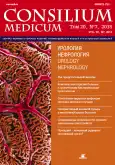Application of a new improved model of a urethral catheter in the treatment and prevention of major pathological conditions of the urinary system
- Authors: Vasilyev A.O1, Govorov A.V1, Schneiderman M.G2, Bykov P.I1, Kim Y.A1, Pushkar D.Y.1
-
Affiliations:
- A.I.Evdokimov Moscow State University of Medicine and Dentistry of the Ministry of Health of the Russian Federation
- V.I.Kulakov National Medical Research Center for Obstetrics, Gynecology and Perinatology of the Ministry of Health of the Russian Federation
- Issue: Vol 20, No 7 (2018)
- Pages: 46-50
- Section: Articles
- URL: https://journals.rcsi.science/2075-1753/article/view/95007
- DOI: https://doi.org/10.26442/2075-1753_2018.7.46-50
- ID: 95007
Cite item
Full Text
Abstract
Full Text
##article.viewOnOriginalSite##About the authors
A. O Vasilyev
A.I.Evdokimov Moscow State University of Medicine and Dentistry of the Ministry of Health of the Russian Federation
Email: alexvasilyev@me.com
канд. мед. наук, ассистент каф. урологии 127473, Russian Federation, Moscow, ul. Delegatskaia, d. 20, str. 1
A. V Govorov
A.I.Evdokimov Moscow State University of Medicine and Dentistry of the Ministry of Health of the Russian Federation
Email: dr.govorov@gmail.com
д-р мед. наук, проф. каф. урологии 127473, Russian Federation, Moscow, ul. Delegatskaia, d. 20, str. 1
M. G Schneiderman
V.I.Kulakov National Medical Research Center for Obstetrics, Gynecology and Perinatology of the Ministry of Health of the Russian Federation
Email: innamike@lmi.net
канд. мед. наук, акушер-гинеколог, врач гинекологического отд-ния восстановительного лечения 117997, Russian Federation, Moscow, ul. Akademika Oparina, d. 4
P. I Bykov
A.I.Evdokimov Moscow State University of Medicine and Dentistry of the Ministry of Health of the Russian Federation
Email: dr.bykov.pavel@gmail.com
ординатор каф. урологии 127473, Russian Federation, Moscow, ul. Delegatskaia, d. 20, str. 1
Yu. A Kim
A.I.Evdokimov Moscow State University of Medicine and Dentistry of the Ministry of Health of the Russian Federation
Email: dockimyura@gmail.com
ординатор каф. урологии 127473, Russian Federation, Moscow, ul. Delegatskaia, d. 20, str. 1
D. Yu Pushkar
A.I.Evdokimov Moscow State University of Medicine and Dentistry of the Ministry of Health of the Russian Federation
Email: pushkardm@mail.ru
чл.-кор. РАН, проф., зав. каф. урологии 127473, Russian Federation, Moscow, ul. Delegatskaia, d. 20, str. 1
References
- Carr H.A. A short history of the Foley catheter: from handmade instrument to infection-prevention device. J Endourol 2000; 14 (1): 5-8.
- Foley F.E.B. Cystoscopic prostatectomy: a new procedure: preliminary report. J Urol 1929; 21: 289-306.
- Пушкарь Д.Ю., Сухих Г.Т., Шнейдерман М.Г. и др. Патент, регистрационный номер 2015105711 «Способ лечения и профилактики воспалительных процессов мочеиспускательного канала в раннем или позднем послеоперационном периодах».
- Пушкарь Д.Ю., Сухих Г.Т., Шнейдерман М.Г. и др. Патент, регистрационный номер 2015105715 «Урологический катетер».
- Васильев А.О., Говоров А.В., Рева И.А. и др. Альтернативные подходы к профилактике и лечению послеоперационных осложнений путем внедрения в практику новых моделей урологического катетера. Урология. 2016; 6: 5-10
- Васильев А.О., Говоров А.В., Ширяев А.А. и др. Роль уретрального катетера в развитии катетер-ассоциированной инфекции мочевыводящих путей. Урология. 2017; 6: 107-11.
- Сosterton J.W. Cystic fibrosis pathogenesis and the role of biofilms in persistent infection. Trends Microbiol 2001; 9 (2): 50-2.
- Tenke P, Kovacs B, Bjerklund Johansen T.E. et al. European and Asian guidelines on management and prevention of catheter-associated urinary tract infections. Int J Antimicrob Agents 2008; 31 (1): 68-78.
- Перепанова Т.С. Значение инфекций, обусловленных образованием биопленок, в урологической практике. Эффективная фармакотерапия. 2013; 37 (4): 18-27.
- Denstedt J.D, Wollin T.A, Reid G. Biomaterials used in urology: Current issues of biocompatibility, infection, and encrustation. J Endourol 1998; 12 (6): 493-500.
- Nickel J.C, McLean R.J.C. Bacterial biofilms in urology. Infect Urol 1998; 11: 169-75.
- Niel-Weise B.S, van den Broek P.J. Urinary catheter policies for long-term bladder drainage. Cochrane Database Syst Rev 2005; 25: CD004201.
- Stickler D.J. Biomaterials to prevent nosocomial infections: is silver the gold standard? Curr Opin Infect Dis 2000; 13: 389-93.
- Brosnahan J, Jull A, Tracy C. Types of urethral catheters for management of short-term voiding problems in hospitalised adults. Cochrane Database Syst Rev 2004; 1: CD004013.
- Pickard R, Lam T, MacLennan G et al. Antimicrobial catheters for reduction of symptomatic urinary tract infection in adults requiring short-term catheterisation in hospital: a multicentre randomised controlled trial. Lancet 2012; 1 (9857): 1927-35.
- Pickard R, Lam T, Maclennan G et al. Types of urethral catheter for reducing symptomatic urinary tract infections inhospitalised adults requiring short-term catheterisation: multicentrera domised controlled trial and economic evaluationof antimicrobialand antiseptic-impregnated urethral catheters (the CATHETER trial). Health Technol Assess 2012; 16 (47): 1-197.
- Desai D.G, Liao K.S, Cevallos M.E. Silver or nitrofurazone impregnation of urinary catheters has a minimal effect on uropathogen adherence. J Urol 2010; 184 (6): 2565-71.
- Rani S.A, Celeri C, Najafi R et al. Irrigation with N,N- dichloro-2,2-dimethyltaurine (NVC-422) in a citrate buffer maintains urinarycatheter patency in vitro and prevents encrustation by Proteus mirabilis. Urolithiasis 2016; 44 (3): 247-56.
- Kumar C.G, Sujitha P. Green synthesis of Kocuran-functionalized silver glyconanoparticles for use as antibiofilm coatings on silicone urethral catheters. Nanotechnology 2014; 25 (32): 325101.
- De Ridder D.J, Everaert K, Ferná́ndez L.G et al. Intermittent catheterisation with hydrophilic-coated catheters (SpeediCath) reduces the risk of clinical urinary tract infection in spinal cord injured patients: a prospective randomised parallel comparative trial. Eur Urol 2005; 48 (6): 991-5.
- Sarica S, Akkoc Y, Karapolat H et al. Comparison of the use of conventional, hydrophilic and gel-lubricated catheters with regard to urethral micro trauma, urinary system infection, and patient satisfaction in patients with spinal cord injury: a randomized controlled study. Eur J Phys Rehabil Med 2010; 46 (4): 473-9.
- Lange D, Elwood C.N, Choi K et al. Uropathogen interaction with the surface of urological stents using different surface properties. J Urol 2009; 182 (3): 1194-200.
- Hachem R, Reitzel R, Borne A et al. Novel antiseptic urinary catheters for prevention of urinary tract infections: correlation of in vivo and in vitro test results. Antimicrob Agents Chemother 2009; 53 (12): 5145-9.
Supplementary files






